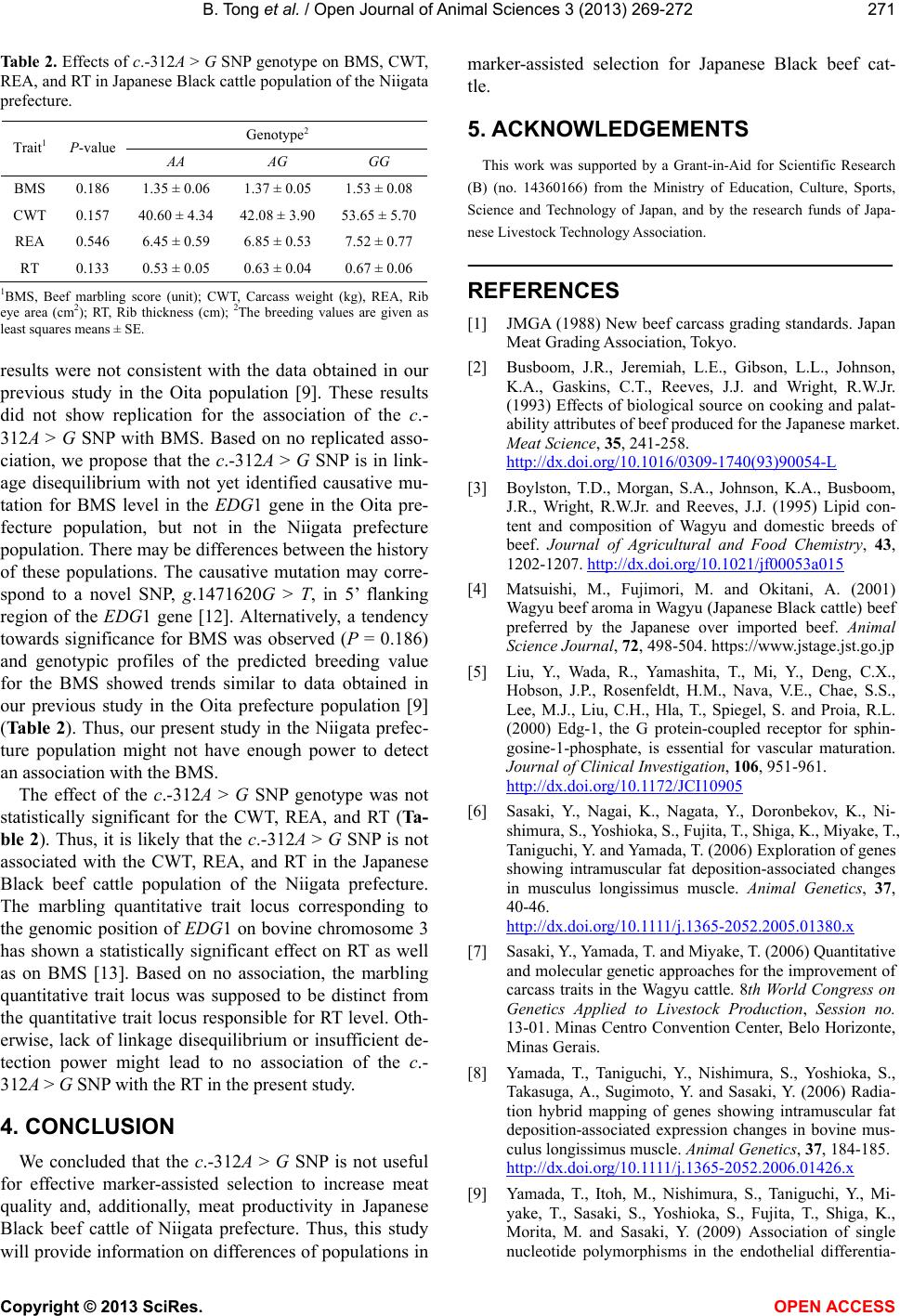
B. Tong et al. / Open Journal of Animal Sciences 3 (2013) 269-272 271
Tabl e 2. Effects of c.-312A > G SNP genotype on BMS, CWT,
REA, and RT in Japanese Black cattle population of the Niigata
prefecture.
Genotype2
Trait1 P-value AA AG GG
BMS 0.186 1.35 ± 0.06 1.37 ± 0.05 1.53 ± 0.08
CWT 0.157 40.60 ± 4.34 42.08 ± 3.90 53.65 ± 5.70
REA 0.546 6.45 ± 0.59 6.85 ± 0.53 7.52 ± 0.77
RT 0.133 0.53 ± 0.05 0.63 ± 0.04 0.67 ± 0.06
1BMS, Beef marbling score (unit); CWT, Carcass weight (kg), REA, Rib
eye area (cm2); RT, Rib thickness (cm); 2The breeding values are given as
least squares means ± SE.
results were not consistent with the data obtained in our
previous study in the Oita population [9]. These results
did not show replication for the association of the c.-
312A > G SNP with BMS. Based on no replicated asso-
ciation, we propose that the c.-312A > G SNP is in link-
age disequilibrium with not yet identified causative mu-
tation for BMS level in the EDG1 gene in the Oita pre-
fecture population, but not in the Niigata prefecture
population. There may be differences between the history
of these populations. The causative mutation may corre-
spond to a novel SNP, g.1471620G > T, in 5’ flanking
region of the EDG1 gene [12]. Alternatively, a tendency
towards significance for BMS was observed (P = 0.186)
and genotypic profiles of the predicted breeding value
for the BMS showed trends similar to data obtained in
our previous study in the Oita prefecture population [9]
(Ta bl e 2). Thus, our present study in the Niigata prefec-
ture population might not have enough power to detect
an association with the BMS.
The effect of the c.-312A > G SNP genotype was not
statistically significant for the CWT, REA, and RT (Ta-
ble 2). Thus, it is likely that the c.-312A > G SNP is not
associated with the CWT, REA, and RT in the Japanese
Black beef cattle population of the Niigata prefecture.
The marbling quantitative trait locus corresponding to
the genomic position of EDG1 on bovine chromosome 3
has shown a statistically significant effect on RT as well
as on BMS [13]. Based on no association, the marbling
quantitative trait locus was supposed to be distinct from
the quantitative trait locus responsible for RT level. Oth-
erwise, lack of linkage disequilibrium or insufficient de-
tection power might lead to no association of the c.-
312A > G SNP with the RT in the present study.
4. CONCLUSION
We concluded that the c.-312A > G SNP is not useful
for effective marker-assisted selection to increase meat
quality and, additionally, meat productivity in Japanese
Black beef cattle of Niigata prefecture. Thus, this study
will provide information on differences of populatio ns in
marker-assisted selection for Japanese Black beef cat-
tle.
5. ACKNOWLEDGEMENTS
This work was supported by a Grant-in-Aid for Scientific Research
(B) (no. 14360166) from the Ministry of Education, Culture, Sports,
Science and Technology of Japan, and by the research funds of Japa-
nese Livestock Technology Association.
REFERENCES
[1] JMGA (1988) New beef carcass grading standards. Japan
Meat Grading Association, Tokyo.
[2] Busboom, J.R., Jeremiah, L.E., Gibson, L.L., Johnson,
K.A., Gaskins, C.T., Reeves, J.J. and Wright, R.W.Jr.
(1993) Effects of biological source on cooking and palat-
ability attributes of beef produced for the Japanese market.
Meat Scie nce, 35, 241-258.
http://dx.doi.org/10.1016/0309-1740(93)90054-L
[3] Boylston, T.D., Morgan, S.A., Johnson, K.A., Busboom,
J.R., Wright, R.W.Jr. and Reeves, J.J. (1995) Lipid con-
tent and composition of Wagyu and domestic breeds of
beef. Journal of Agricultural and Food Chemistry, 43,
1202-1207. http://dx.doi.org/10.1021/jf00053a015
[4] Matsuishi, M., Fujimori, M. and Okitani, A. (2001)
Wagyu beef aroma in Wagyu (Japanese Black cattle) beef
preferred by the Japanese over imported beef. Animal
Science Journal, 72, 498-504. https://www.jstage.jst.go.jp
[5] Liu, Y., Wada, R., Yamashita, T., Mi, Y., Deng, C.X.,
Hobson, J.P., Rosenfeldt, H.M., Nava, V.E., Chae, S.S.,
Lee, M.J., Liu, C.H., Hla, T., Spiegel, S. and Proia, R.L.
(2000) Edg-1, the G protein-coupled receptor for sphin-
gosine-1-phosphate, is essential for vascular maturation.
Journal of Clinical Investigation, 106, 951-961.
http://dx.doi.org/10.1172/JCI10905
[6] Sasaki, Y., Nagai, K., Nagata, Y., Doronbekov, K., Ni-
shimura, S., Yoshioka, S., Fujita, T., Shiga, K., Miyake, T.,
Taniguchi, Y. and Yamada, T. (2006) Exploration of genes
showing intramuscular fat deposition-associated changes
in musculus longissimus muscle. Animal Genetics, 37,
40-46.
http://dx. doi.o rg/10.1111/j .1365-2052.2005.01380.x
[7] Sasaki, Y., Yamada, T. and Miyake, T. (2006) Quantitative
and molecular genetic approaches for the improvement of
carcass traits in the Wagyu cattle. 8th World Congress on
Genetics Applied to Livestock Production, Session no.
13-01. Minas Centro Convention Center, Belo Horizonte,
Minas Gerais.
[8] Yamada, T., Taniguchi, Y., Nishimura, S., Yoshioka, S.,
Takasuga, A., Sugimoto, Y. and Sasaki, Y. (2006) Radia-
tion hybrid mapping of genes showing intramuscular fat
deposition-associated expression changes in bovine mus-
culus longissimus muscle. Animal Genetics, 37, 184-185.
http://dx. doi.o rg/10.1111/j .1365-2052.2006.01426.x
[9] Yamada, T., Itoh, M., Nishimura, S., Taniguchi, Y., Mi-
yake, T., Sasaki, S., Yoshioka, S., Fujita, T., Shiga, K.,
Morita, M. and Sasaki, Y. (2009) Association of single
nucleotide polymorphisms in the endothelial differentia-
Copyright © 2013 SciRes. OPEN ACCESS